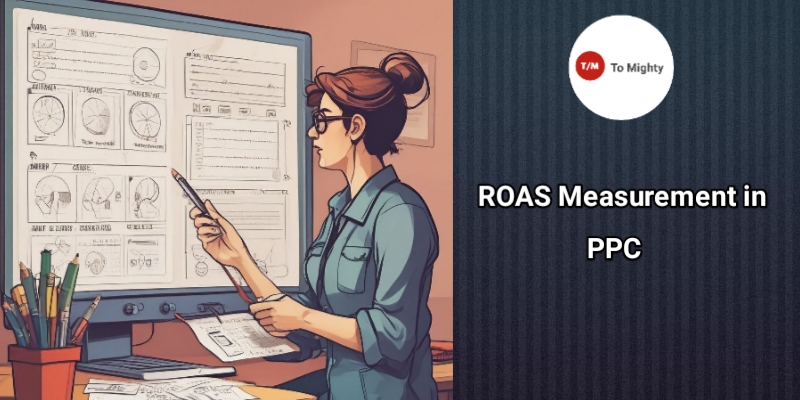How to measure ROAS on PPC campaigns is a common concern for advertisers who want to make sense of their ad spend. Whether you’re running Google Ads, Facebook campaigns, or promoting across multiple ad platforms, understanding your Return on Ad Spend (ROAS) is key to knowing whether your campaigns are truly bringing value.
What Is ROAS in Simple Words?
ROAS stands for Return on Ad Spend. It’s a marketing metric that helps you figure out how much revenue you’re generating for every rupee or dollar spent on ads. It gives you clarity on whether your campaigns are doing well or just burning your budget. For example, if you spend ₹5,000 on an ad and earn ₹20,000 in sales, your ROAS is 4 — meaning you got ₹4 for every ₹1 you spent.
Why ROAS Matters in PPC Advertising?
If you’re managing a PPC campaign, you’re likely tracking clicks, impressions, and maybe conversions. But those numbers don’t tell you the complete story. ROAS gives you the business insight behind those clicks. It’s the number that can tell you if your ad spend is paying off or not. Many advertisers get lost in click-through rates or cost per click, but without measuring ROAS, you might miss the bigger picture — actual profit.
How to Calculate ROAS in PPC Campaigns?
Calculating ROAS is straightforward. The formula goes like this:
ROAS = Revenue from Ads / Cost of Ads
So if your PPC campaign generated ₹50,000 in sales and you spent ₹10,000 on ads, your ROAS is 5.
But here’s where it gets tricky — revenue data needs to be tracked accurately. You have to ensure conversion tracking is properly set up and revenue from each ad source is clearly attributed. If you’re using tools like Google Ads or Facebook Ads, you can integrate your analytics or eCommerce platform to track real-time data.
Difference Between ROAS and ROI
Many advertisers confuse ROAS with ROI (Return on Investment), but they’re not the same. ROI takes into account all business expenses — product cost, salaries, logistics, etc. ROAS only compares ad spend with ad revenue. It’s a cleaner and more focused metric for ad campaign evaluation.
What’s a Good ROAS?
There’s no universal answer. It depends on your business type, product margin, and campaign goal. For some businesses, a ROAS of 3 might be acceptable, meaning for every ₹1 spent, you’re earning ₹3. But if your product has low margins, even a ROAS of 5 might not be enough. You need to calculate your breakeven ROAS — the point where ad cost and revenue balance out.
How to Track ROAS on Different Ad Platforms
Let’s break it down by platform.
➡️ Google Ads: Go to your campaign view and check the “Conv. value / cost” metric. This shows your ROAS directly.
➡️ Facebook Ads: In Ads Manager, customize your columns to include “Purchase ROAS” and you’ll see how much each ad set is generating.
➡️ Other Tools: Platforms like Shopify, WooCommerce, or CRM tools can integrate with your ad platforms to give you a more complete view.
Common Mistakes While Measuring ROAS
1. Not tracking all conversions: If you’re not capturing every purchase or lead correctly, your ROAS will be off.
2. Using last-click attribution only: This method gives all credit to the final touchpoint. Consider switching to data-driven or time decay models.
3. Ignoring lifetime value (LTV): ROAS often measures only the first sale, but if your customers come back and buy again, you should factor that in.
How to Improve ROAS in PPC Campaigns?
Once you know how to measure ROAS, the next step is to improve it. You can start by cutting out underperforming keywords, optimizing your ad creatives, and adjusting bids for better-performing devices or times. Also, check your landing page. If the ad brings users to a slow or confusing page, your ROAS will suffer.
Use Smart Bidding and Target ROAS Settings
Platforms like Google Ads allow you to use bidding strategies where you can set a target ROAS. This helps the system automatically adjust your bids to achieve your desired return. It’s especially useful if you’re running large campaigns across multiple ad groups.
Real-Time Tracking Helps Make Smarter Decisions
You should not wait till the end of the month to check your ROAS. Use real-time dashboards or integrate your ad platforms with reporting tools like Google Data Studio. That way, if something is not working, you can fix it early.
Should You Focus Only on ROAS?
While ROAS is a very important metric, you shouldn’t ignore other indicators. For example, if your ads bring new users who engage with your brand, it may not result in immediate purchases but could pay off in the long run. So use ROAS as your main performance indicator, but not the only one.
Final Say
ROAS helps you look beyond surface metrics and understand whether your ad budget is helping your business grow or not. It’s not just about traffic or leads — it’s about how much value you’re truly getting back from your campaigns. By knowing how to calculate, track, and improve ROAS, you’ll be able to take better decisions that protect your money and boost your performance.
For more insights that matter to your business, keep following To Mighty.
Sheikh Faraz is a talented writer with years of experience in creating content on a variety of topics. From cricket and beauty to fashion, education, and general knowledge, he has a knack for turning complex ideas into simple, easy-to-understand articles. His writing is clear, relatable, and always focused on providing value to his readers.
With a strong passion for storytelling, Sheikh Faraz takes pride in delivering well-researched and engaging content. Whether it’s breaking down the latest cricket match, sharing practical beauty tips, or exploring new fashion trends, his work reflects his dedication to quality and authenticity.



